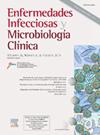Recuperación del patrón de incremento de las infecciones de transmisión sexual (ITS) después de la pandemia de COVID-19: el caso de la gonococia en Cataluña, España
IF 2.5
4区 医学
Q3 INFECTIOUS DISEASES
Enfermedades infecciosas y microbiologia clinica
Pub Date : 2025-06-01
DOI:10.1016/j.eimc.2024.11.008
引用次数: 0
Abstract
Introduction
Sexually transmitted infections (STI) have shown a sustained increase in recent years. Changes in epidemiological patterns highlight the need to adapt public health strategies for their prevention and control. The objective of this study is to describe the trend of reported gonorrhea cases in Catalonia (Spain) from 2017 to 2023 and to compare the epidemiological pattern of reported cases before, during, and after the COVID-19 pandemic.
Methods
Descriptive analysis of reported gonorrhea cases in Catalonia among individuals aged ≥ 14 years between 2017 and 2023. Incidence rates (IR) were calculated overall and by sex, age, and origin. A descriptive analysis was conducted to compare reported cases across the pre-pandemic (2017-2019), pandemic (2020), and post-pandemic (2021-2023) periods.
Results
The IR of gonorrhea showed an average increase of 32.9% between 2017-2019 and 37.9% between 2021-2023, reaching 164.0 cases per 100,000 inhabitants in 2023. During the pandemic, there was an increase in the proportion of cases among MSM (13.3%), alcohol use (40.0%), having ≥ 6 sexual partners (30.5%), and new sexual partners (74.3%). In the post-pandemic period, the highest percentage increase was observed in women (115.7%), Spanish nationals (124.9%), cases reported in sexual and reproductive health units (30.9%), symptomatic cases (58.0%), and reinfections (33.0%). Additionally, there was a decrease in the average age, particularly among women, in contact tracing studies (13.1%), and in antibiotic resistance.
Conclusions
Gonorrhea continues to rise, especially among young people and women. Strengthening its visibility and prioritizing it in STI prevention and control programs is crucial to mitigate its impact on public health.
恢复2019冠状病毒病大流行后性传播感染(STI)上升模式:西班牙加泰罗尼亚淋病病例
近年来,性传播感染(STI)呈持续增长趋势。流行病学形态的变化突出表明,需要调整公共卫生战略以预防和控制流行病学。本研究的目的是描述2017年至2023年加泰罗尼亚(西班牙)报告淋病病例的趋势,并比较2019冠状病毒病大流行之前、期间和之后报告病例的流行病学模式。方法对2017 - 2023年加泰罗尼亚地区14岁以上人群报告的淋病病例进行描述性分析。发病率(IR)按总体、性别、年龄和原产国计算。进行了描述性分析,以比较大流行前(2017-2019年)、大流行(2020年)和大流行后(2021-2023年)期间的报告病例。结果2017-2019年淋病发病率平均上升32.9%,2021-2023年平均上升37.9%,2023年达到164.0例/ 10万居民。在大流行期间,男男性行为者(13.3%)、酒精使用者(40.0%)、拥有6名以上性伴侣(30.5%)和新的性伴侣(74.3%)的病例比例有所增加。在大流行后的时期,妇女(115.7%)、西班牙国民(124.9%)、在性健康和生殖健康部门报告的病例(30.9%)、有症状病例(58.0%)和再感染(33.0%)的百分比增长最高。此外,接触者追踪研究的平均年龄(特别是女性)和抗生素耐药性也有所下降(13.1%)。结论淋病发病率持续上升,尤其是在年轻人和妇女中。加强其可见度并在性传播感染预防和控制规划中将其列为优先事项,对于减轻其对公共卫生的影响至关重要。
本文章由计算机程序翻译,如有差异,请以英文原文为准。
求助全文
约1分钟内获得全文
求助全文
来源期刊
CiteScore
2.10
自引率
8.00%
发文量
194
审稿时长
29 days
期刊介绍:
Hoy está universalmente reconocida la renovada y creciente importancia de la patología infecciosa: aparición de nuevos agentes patógenos, de cepas resistentes, de procesos con expresión clínica hasta ahora desconocida, de cuadros de una gran complejidad. Paralelamente, la Microbiología y la Infectología Clínicas han experimentado un gran desarrollo como respuesta al reto planteado por la actual patología infecciosa. Enfermedades Infecciosas y Microbiología Clínica es la Publicación Oficial de la Sociedad Española SEIMC. Cumple con la garantía científica de esta Sociedad, la doble función de difundir trabajos de investigación, tanto clínicos como microbiológicos, referidos a la patología infecciosa, y contribuye a la formación continuada de los interesados en aquella patología mediante artículos orientados a ese fin y elaborados por autores de la mayor calificación invitados por la revista.

 求助内容:
求助内容: 应助结果提醒方式:
应助结果提醒方式:


